|
Author
|
Topic: STS-120: Tear in solar array
|
Robert Pearlman
Editor Posts: 42988
From: Houston, TX
Registered: Nov 1999
|
 posted 10-30-2007 11:41 AM
posted 10-30-2007 11:41 AM
   
STS-120 spacewalkers Scott Parazynski and Doug Wheelock helped install the P6 truss in its permanent location today, on the end of the P5 truss. Re-deployment of the P6 solar arrays began well with the P6-2B wing unfurling without issue. The same was true for the 115-foot P6-4B until nearly the end of the deploy, when ISS Expedition 16 commander Peggy Whitson spotted a tear in the right array:  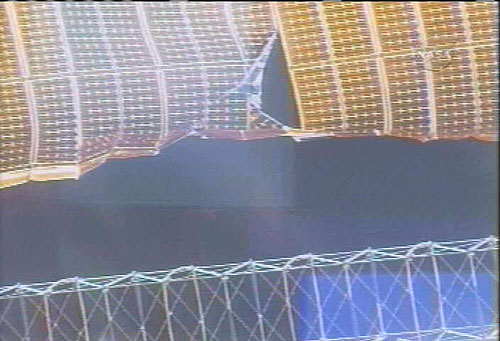 Flight controllers have asked the astronauts to downlink photos of the tear. |
Robert Pearlman
Editor Posts: 42988
From: Houston, TX
Registered: Nov 1999
|
 posted 10-30-2007 11:49 AM
posted 10-30-2007 11:49 AM
   
 |
Robert Pearlman
Editor Posts: 42988
From: Houston, TX
Registered: Nov 1999
|
 posted 10-30-2007 11:54 AM
posted 10-30-2007 11:54 AM
   
Peggy Whitson reports that "the outer edge does appear to be intact." 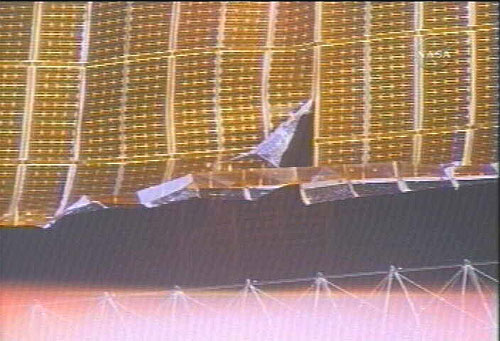 |
Robert Pearlman
Editor Posts: 42988
From: Houston, TX
Registered: Nov 1999
|
 posted 10-30-2007 12:33 PM
posted 10-30-2007 12:33 PM
   
According to STS-120 commander Pam Melroy, pilot George Zamka and mission specialist Stephanie Wilson believe they have been able to nail down the moment when the tear occurred by analyzing a video shot from Discovery's window."And that would be 16, GMT, 16:24:38," radioed Melroy [11:24:38 a.m. CDT] |
Robert Pearlman
Editor Posts: 42988
From: Houston, TX
Registered: Nov 1999
|
 posted 10-30-2007 12:38 PM
posted 10-30-2007 12:38 PM
   
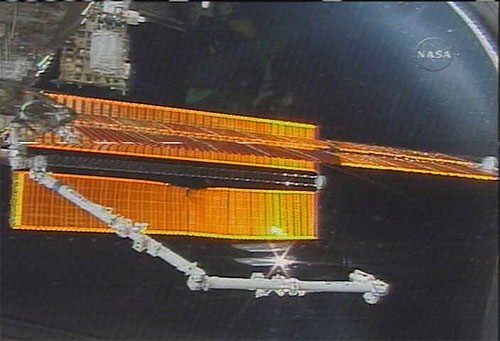 |
Robert Pearlman
Editor Posts: 42988
From: Houston, TX
Registered: Nov 1999
|
 posted 10-30-2007 12:41 PM
posted 10-30-2007 12:41 PM
   
 |
divemaster
Member Posts: 1376
From: ridgefield, ct
Registered: May 2002
|
 posted 10-30-2007 12:49 PM
posted 10-30-2007 12:49 PM
   
Looks like another job for WD-40 and duct tape while they're fixing the SARJI guess they'd have to use Kapton tape on this one, though. |
Robert Pearlman
Editor Posts: 42988
From: Houston, TX
Registered: Nov 1999
|
 posted 10-30-2007 02:14 PM
posted 10-30-2007 02:14 PM
   
 Download the high resolution version (4.46mb) Download the high resolution version (4.46mb) |
Jay Chladek
Member Posts: 2272
From: Bellevue, NE, USA
Registered: Aug 2007
|
 posted 10-30-2007 02:21 PM
posted 10-30-2007 02:21 PM
   
Would that be what the Kapton tape is normally used for, to patch holes in solar arrays?Looks like EVA 4 is going to be the "Mr. Goodwrench" flight with inspections of the ailing SARJ and more then likely a patch of the solar array tear. Crazy stuff! The really tricky bit though will be for the crew and controllers to come up with an RMS position for an astronaut. The shuttle RMS can't get that far and I don't think the RMS 2 can go that high. Only solution I can think of would be RMS 2 with the OBSS in its grasp to allow a spacewalking astronaut to get a firm brace to make a Kapton tape repair. |
Robert Pearlman
Editor Posts: 42988
From: Houston, TX
Registered: Nov 1999
|
 posted 10-30-2007 02:22 PM
posted 10-30-2007 02:22 PM
   
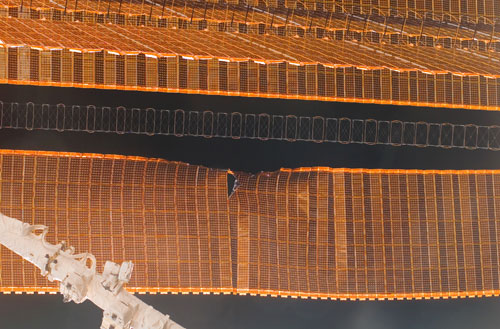 Download the high resolution version (6.42mb) Download the high resolution version (6.42mb) |
Robert Pearlman
Editor Posts: 42988
From: Houston, TX
Registered: Nov 1999
|
 posted 10-30-2007 03:38 PM
posted 10-30-2007 03:38 PM
   
quote:
Originally posted by Jay Chladek:
Looks like EVA 4 is going to be the "Mr. Goodwrench" flight with inspections of the ailing SARJ and more then likely a patch of the solar array tear.
According to station manager Michael Suffredini, P6-4B has priority for the fourth spacwalk, assuming they have the time between now and then to develop a plan for the crew. He'd like to see them address both the array and rotary joint but assuring good power through P6 is paramount. The good news is that they don't believe the array's power lines were severed by the 2.5 foot long tear, as they are still seeing the power generation they would expect to see with an intact wing. It does appear however, that the outer hinge has come free from the panel, which is troublesome as it is through the weight-bearing hinge that the wing is pulled taught, which in turn is necessary for the array to be structurally stable for the solar alpha rotary joint (SARJ) to safely rotate and track the sun. quote:
Only solution I can think of would be RMS 2 with the OBSS in its grasp to allow a spacewalking astronaut to get a firm brace to make a Kapton tape repair.
One problem, though not unsurmountable, is that the OBSS grapple is not compatible with the SSRMS, thus its instrumentation (e.g. cameras) would not be powered if used in such a manner. Of course, that might not be required for this intended use, but it is not ideal. |
Jay Chladek
Member Posts: 2272
From: Bellevue, NE, USA
Registered: Aug 2007
|
 posted 10-30-2007 06:09 PM
posted 10-30-2007 06:09 PM
   
Well, we know guys with a lot more engineering knowledge are looking at this problem and solution. As such, this is speculation on my part. Even without the cameras on OBSS being compatible with RMS 2, the camera feed from the helmet camera of an astronaut during EVA should allow for a visual inspection to be downlinked to the ground easily enough. Granted we all know how engineers love to collect data whenever possible with cameras and sensors.If RMS 2 can grapple OBSS and hold it stable enough, that would be the only effective way I can see putting someone out there to inspect and repair it unless they try retracting the array to a closer point. As ominous as that tear looks, I would be more worried about the potential ramifications of pulling it back, considering the challenge of folding it back the first time on a couple previous missions (without tears). Of course, this is probably the discussion going on during an MMT meeting at this time anyway. Quite a challenge they have to work through with this little problem. |
divemaster
Member Posts: 1376
From: ridgefield, ct
Registered: May 2002
|
 posted 10-30-2007 10:36 PM
posted 10-30-2007 10:36 PM
   
I wonder if it's possible to swap out the damaged array with one of the S6 array's that's supposed to go up in a year on STS-119. Bring the current array home, fix it, and put it back up on the S6 flight.Probably impossible to do, but an interesting thought to ponder about.
|
Jay Chladek
Member Posts: 2272
From: Bellevue, NE, USA
Registered: Aug 2007
|
 posted 10-30-2007 10:56 PM
posted 10-30-2007 10:56 PM
   
I had thought about that myself. Considering the tear though, it could be a real chore to get the thing furled up properly. It was hard enough to get it stowed on the last couple of flights and it didn't have the tear then (but plenty of other little snags in the system resulting from age). |
cspg
Member Posts: 6210
From: Geneva, Switzerland
Registered: May 2006
|
 posted 10-31-2007 05:12 AM
posted 10-31-2007 05:12 AM
   
I'm no engineer but does it really make sense from an engineering and assembly secquence complexity points of view to keep furling/unfurling solar arrays, moving around truss segments, placing modules in temporary locations (Harmony)?
Wouldn't it be better to launch a station element and place it into its definitive position once and for all? In view of the fragility of these components and the extreme conditions they operate in, it would make more sense...(well, at least to me!- just following the K.I.S.S rule). Just a thought.Chris. |
Robert Pearlman
Editor Posts: 42988
From: Houston, TX
Registered: Nov 1999
|
 posted 10-31-2007 09:42 AM
posted 10-31-2007 09:42 AM
   
The crew is currently talking with flight controllers over a private conference regarding planning for the fourth spacewalk. At issue is whether to proceed with plans to inspect the faulty starboard solar alpha rotary joint (SARJ) or to redirect the astronauts' efforts to repairing the tear in the P6-4B solar array.Station manager Michael Suffredini had previously said that the deployment of the arrays would take precedence, however there are only a few options for how spacewalkers might reach the P6-4B array and with those come trade-offs that could affect the remainder of the STS-120 mission. There are reports that the chosen course of action may include using the orbiter's boom (OBSS) attached to the space station's robotic arm to reach the damaged array, but a final decision has yet to be reached. More information will be posted as known. |
Robert Pearlman
Editor Posts: 42988
From: Houston, TX
Registered: Nov 1999
|
 posted 10-31-2007 09:55 AM
posted 10-31-2007 09:55 AM
   
An update from Bill Harwood (CBS/Spaceflight Now): quote:
NASA and contractor engineers worked through the night assessing a variety of options for possible repairs to fix a ripped solar blanket on a partially extended space station array. Station program managers recommended early today, sources said, that NASA delay a fourth spacewalk from Thursday to Friday and devote the excursion to solar array repair work.Under that scenario, the astronauts would forego any immediate inspection of a contaminated solar array rotary joint, deferring that work to a later mission, and delay a spacewalk by station commander Peggy Whitson and flight engineer Yuri Malenchenko until after the shuttle Discovery departs.
|
Robert Pearlman
Editor Posts: 42988
From: Houston, TX
Registered: Nov 1999
|
 posted 10-31-2007 10:13 AM
posted 10-31-2007 10:13 AM
   
Capcom Tony Antonelli advised the STS-120 crew: "We're going to change the plan for the next couple of days. EVA 4 will not be executed on Flight Day 10 [Thursday]. We're going to shoot for Flight Day 11 and then if we get that accomplished, the contents of which will be solar array wing stuff, and you'll hear more about that in the conference.* We'll leave Flight Day 11 as a placeholder for now, but if we don't get ready, we'll try for Flight Day 12."* An EVA planning conference for ground controllers is currently scheduled for later this hour. |
Jay Chladek
Member Posts: 2272
From: Bellevue, NE, USA
Registered: Aug 2007
|
 posted 10-31-2007 01:59 PM
posted 10-31-2007 01:59 PM
   
Concerning the relocation of modules, to me only the solar arrays have unique challenges as the rest of the modules seem to hold up much better. Granted some of the ammonia coolant lines could be a bit tricky to relocate during the movement of the PMA to the end of Harmony, but its not as big a challenge as the solar arrays in my mind.I will have to check, but I think part of the reason why the first Solar Array was installed first in a vertical position relative to the station had to do with the Russians being unable to supply the planned solar array tower for the Russian segment. Although it does seem that the station was designed early on with the capability to put the array there. Columbia's loss didn't help matters as that P6 array spent over three more years unfurled then originally planned. As I recall in the sequence, two of the next four missions right after STS-107 returned would have involved pretty much the same solar array assembly sequence we saw on STS-115, 116 and 117. If Columbia hadn't been lost, then these steps would have taken place within a year of the P6 array's original deployment. Besides, not all science in orbit is deliberate either. Doing a construction project this big means that there can be some unforseen obsticles to overcome. If a mission to Mars has a similar situation develop, they aren't going to have the benefits of a shuttle docked, or the ability to send up spare parts. It is going to be up to the guys on that craft to come up with a fix for it, with guidance from the ground. |
Robert Pearlman
Editor Posts: 42988
From: Houston, TX
Registered: Nov 1999
|
 posted 10-31-2007 02:57 PM
posted 10-31-2007 02:57 PM
   
Mission managers are planning to use the space station's robotic arm (SSRMS) in combination with the orbiter's boom (OBSS) to bring a spacewalking astronaut within arm's length of the tears in the P6-4B solar array, in order to both assess the situation and effect a repair.There are two tears: a 2.5-foot tear (that can be seen in the photos above) and a second tear, about 1/3 in size, in the outboard bay. Controllers believe that the damage occurred after a guide wire became hard snagged in a grommet (a ring through which the guide wire passes). STS-120 spacewalker Scott Parazysnki will anchor himself on one end of the OBSS, which itself will be grappled by the SSRMS from its middle post, to be positioned by arm operator Dan Tani to the site of the tears. Meanwhile, Doug Wheelock will position himself at the base of the P6 truss, to assist with observing clearances for the arm. Controllers are still working on the details of what Parazynski will do once at the array, but he will attempt the clear the snag. If that cannot be done, he may cut one or two of the guide wires to release the snag. He will then install load-bearing straps to allow the array to be fully extended without risk to further damaging the array. As of now, Parazynski will not try to repair the tears themselves. If the array can be deployed and deemed structurally sound, then the ISS program is content with operating at 95% power generation (though the P6 array) for the remainder of the station's on-orbit life. The hope is that Parazynski and Wheelock will be able to complete the work necessary during the mission's fourth spacewalk, presently scheduled for Friday. However, should they need more time, a fifth spacewalk could be made on Sunday, extending STS-120 by another day. (The originally-scheduled fifth spacewalk to be conducted by Peggy Whitson and Dan Tani will wait until after Discovery has departed the space station.) |
Robert Pearlman
Editor Posts: 42988
From: Houston, TX
Registered: Nov 1999
|
 posted 10-31-2007 03:03 PM
posted 10-31-2007 03:03 PM
   
quote:
Originally posted by Robert Pearlman:
One problem, though not unsurmountable, is that the OBSS grapple is not compatible with the SSRMS, thus its instrumentation (e.g. cameras) would not be powered if used in such a manner.
To address my own concern, the issue is less one of using the boom's sensor system, but rather protecting it from freezing (without power, its internal heaters would be inactive). According to mission managers, they believe they have enough exposure to the Sun to prevent the sensors from being damaged, such that the OBSS would be available for use (as needed) for late inspections of the orbiter. |
Robert Pearlman
Editor Posts: 42988
From: Houston, TX
Registered: Nov 1999
|
 posted 11-01-2007 06:46 PM
posted 11-01-2007 06:46 PM
   
The STS-120 and ISS Expedition 16 crews spent the day assembling tools and readying for a spacewalk, now scheduled for Saturday, to repair a torn solar array.Using strips of aluminum, a hole punch, bolt connector and 66 feet of wire, astronauts constructed solar array hinge stabilizers that should allow them to take the pressure off of the damaged hinges on the solar array. 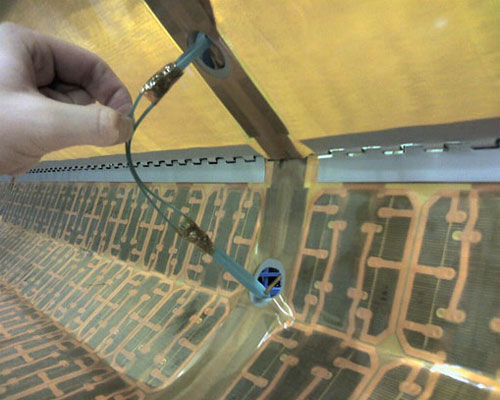 The contraption will work similarly to a cufflink, with the wire fed through a hole on the solar array and the strip of aluminum supporting it from below. 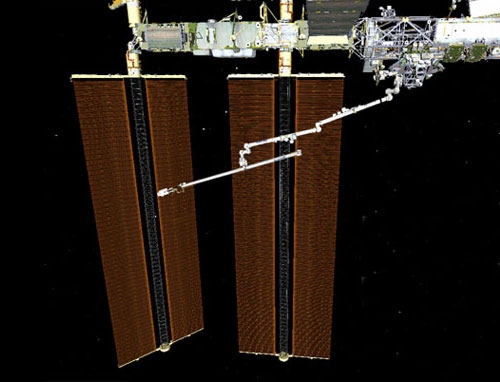 Scott Parazynski will make the repair while suspended from a boom attached to the station's robotic arm. Doug Wheelock will assist from the station's truss. Stephanie Wilson and Dan Tani will be operating the the robotic arm from the work station inside the Destiny laboratory. The following summary of the prepare was uplinked to the crews aboard the shuttle and ISS: quote:
Summary Discussion of Blanket RepairOne of the solar array blanket Grommets has become snagged on the guide wire. This has caused a bunch of the panels to be pushed out ahead of this snag. When no more panels were in the box to be pulled out, the tension in the cable pulled on that grommet and ripped the piano hinge of the blanket between two panels. Best case, if we could clear that snag point, the bunched up panels (grommets) above/beyond the snag would slide down the guide wire towards the base and unload the guide wire. We suspect that whatever caused the snag at that one grommet may continue to snag other grommets. We really don't know if the problem is with a cut or bent grommet or a kink or fray in the guide wire. As the array deploys, this bad spot continues to extend and will eventually move out of our reach with a crewman on the boom. Our first move will be to try and clear the snag and evaluate how the cable behaves with the next grommets. In addition to taking care of this snag, we also have to repair the torn blanket hinge. We have developed these splints (here to known as cuff links) of stiff wire that can be installed into guide pin holes to position that blanket flap back to a normal position. Each end has a toggle like a cuff link that can be inserted into the hole. It should toggle automatically so it won't come out. The snag has to be released first so the torn flap can be repaired before that part of the array deploys out beyond our reach. In the end, we may need 3-5 of these installed to repair the blanket. If we could get 100% confident that it would not snag again, we could continue deploy. If it is going to snag again, we need to get that out of the system before it gets out of our reach. It seems unlikely we will have an identifiably bad grommet that we could cut out (not an easy thing to do). It also seems unlikely we will be able to get 100% confident the cable will not snag again. We will try first to tease the cable snag point (fray or kink) through the 10-15grommets we know it still has to pass through to get to full deployment. We need you to pull on the blankets so the bunched up panels outboard of the snag are all flat and fully deployed on the final side of the snag where they are supposed to be in the final configuration If the above will not work, that will lead us to cutting the cable. We believe the cable is really there just to keep things aligned during retraction so the array can live without it in the final deployed configuration. The tension in the cable is only 1 pound. We are continuing to analyze this. If we cut the cable, we will need to cut it both above and below the snag point (fray/kink). Cutting below the snag point (towards the base) should be done firstso the clean cable can retract back to the base into its reel. We need to control the speed of retraction. This could be accomplished with the TPS Scraper (other crewman needs needle nose pliers) at the base of the array where the cable goes into the box. Press the tool against it to act as a brake. This inboard reel housing completely encloses the reel. We don't care what the cable does in the reel housing area in the end. The worst it could do is bundle up in a mess and stop the retraction. This would leave cable below the snag captured in the grommets much like the cable above the snag. The cable outboard/above the snag point will remain a fixed length and should just remain captured in the grommets above the snag point. We want to cut it as close to the tip as we can to minimize its length.
|
Lunatiki
Member Posts: 237
From: Amarillo, TX, USA
Registered: Dec 2006
|
 posted 11-01-2007 06:53 PM
posted 11-01-2007 06:53 PM
  
Sounds like one heck of a spacewalk. Perhaps rivals or surpasses the Hubble fix? |
NavySpaceFan
Member Posts: 655
From: Norfolk, VA
Registered: May 2007
|
 posted 11-01-2007 06:55 PM
posted 11-01-2007 06:55 PM
   
If they succeed, this will rival the saving of Skylab as the greatest feat of on orbit repair. |
Lunatiki
Member Posts: 237
From: Amarillo, TX, USA
Registered: Dec 2006
|
 posted 11-01-2007 07:03 PM
posted 11-01-2007 07:03 PM
  
Yes, I agree. With Hubble, they had how long to prepare for mission and spacewalk? Will it be aired live? Lastly, Scott Parazynski's name recognition is certainly going to go up. |
Robert Pearlman
Editor Posts: 42988
From: Houston, TX
Registered: Nov 1999
|
 posted 11-01-2007 07:15 PM
posted 11-01-2007 07:15 PM
   
quote:
Originally posted by Lunatiki:
Will it be aired live?
NASA TV will provide live coverage of the spacewalk, which is scheduled (as of now) to begin at 5:28 a.m. CDT (1028 GMT). |
Jay Chladek
Member Posts: 2272
From: Bellevue, NE, USA
Registered: Aug 2007
|
 posted 11-01-2007 08:01 PM
posted 11-01-2007 08:01 PM
   
quote:
Originally posted by NavySpaceFan:
If they succeed, this will rival the saving of Skylab as the greatest feat of on orbit repair.
Skylab was a bit more seat of the pants. But actually the Russians get the record for best save of a space station when the crew of Soyuz T-13 managed to successfully save the Salyut 7 space station. Granted there were no EVA repairs done, but they did manage to dock successfully by manual with a completely dead and slowly tumbling Salyut and spent the next few weeks bringing it back online and fully operational. I have to wonder if Arthur Clarke got inspiration from that mission when he wrote about the salvage of the Spaceship Discovery in his book "2010: Odyssey 2". Still, this mission will rank up there for on-orbit repair work. But it is a lot more carefully planned and less seat of the pants then the glory days of Skylab with Pete Conrad tumbling rear end over tea kettle when he managed to free the stuck solar array on that baby. Lets hope this repair goes well at least. |
Robert Pearlman
Editor Posts: 42988
From: Houston, TX
Registered: Nov 1999
|
 posted 11-02-2007 05:46 AM
posted 11-02-2007 05:46 AM
   
Make your own Space Station Cufflink™...How to build space station-saving cufflinks quote:
How exactly does one assemble a space station saving cufflink from spare parts? Very carefully, as appears to be the case in this, the seven-part instructions that were uplinked to the astronauts, complete with illustrations for key steps.
|
NavySpaceFan
Member Posts: 655
From: Norfolk, VA
Registered: May 2007
|
 posted 11-02-2007 07:22 AM
posted 11-02-2007 07:22 AM
   
quote:
Originally posted by Jay Chladek:
Skylab was a bit more seat of the pants. But actually the Russians get the record for best save of a space station when the crew of Soyuz T-13 managed to successfully save the Salyut 7 space station.
Was not aware of the Salyut 7 difficulties, it sounds like a major feat indeed. One advantage the Skylab 1 crew had in their repair efforts was that they had some preparation on the ground before they went up. Tomorrow's repairs would be a total on orbit excercise, especially in the equiping stage. The work Dr. Whitson and COL Zamka were doing yesterday reminded me of the Apollo 13 "mailbox" assembly. |
Jay Chladek
Member Posts: 2272
From: Bellevue, NE, USA
Registered: Aug 2007
|
 posted 11-02-2007 09:14 AM
posted 11-02-2007 09:14 AM
   
Apollo 13's CO2 scrubber came to mind for me as well, or perhaps the Syncom satellite flyswatters from STS-51D (even if those did not work to activate the satellite). It will certainly be a fun EVA to watch at least.  |
Robert Pearlman
Editor Posts: 42988
From: Houston, TX
Registered: Nov 1999
|
 posted 11-03-2007 01:09 AM
posted 11-03-2007 01:09 AM
   
Today's spacewalk is scheduled to begin at 5:28 a.m. CDT, though it may start as early as (or earlier than) 5:00 a.m. depending on how quickly Scott Parazynski and Doug Wheelock prepare to exit the International Space Station. Once outside, Parazynski will anchor himself to the orbiter's boom (OBSS), which has already been grappled by the station's robotic arm (SSRMS). Stephanie Wilson and Dan Tani will control the arm to position Parazynski near where the P6-4B array was torn, as the following two images illustrate: 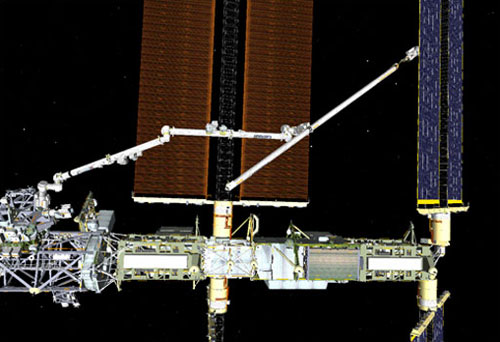  Once positioned, Parazynski will assess the condition of the array, providing the first up close inspection of the damage. If, as ground controllers believe, the tears were caused by a snagged guide wire, Parazynski, assisted by Wheelock stationed at the base of the P6 array, will try to clear the snag and if necessary, cut the guide wire free. Parazynski will also install five hinge stabilizers, or "cufflinks", to allow the array to be fully extended without putting additional tension on the tears. The cufflinks will be installed as follows: 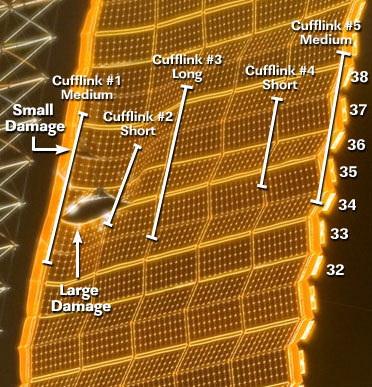 The spacewalk is expected to run approximately 6.5 hours. Parazynski's translation to the array will take about 45 minutes. His work at the array could be completed as quickly as 30 minutes, though three hours have been allocated by flight controllers. |
Robert Pearlman
Editor Posts: 42988
From: Houston, TX
Registered: Nov 1999
|
 posted 11-03-2007 05:07 AM
posted 11-03-2007 05:07 AM
   
Today's projected 6.5-hour spacewalk to repair a solar array began at 5:03 a.m. CDT, as spacewalkers Scott Parazynksi and Doug Wheelock switched their spacesuits' to internal battery power. 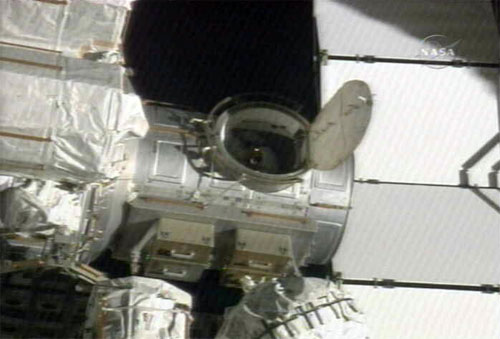 This is the fourth EVA during the STS-120 mission and the 96th spacewalk devoted to station assembly. |
Robert Pearlman
Editor Posts: 42988
From: Houston, TX
Registered: Nov 1999
|
 posted 11-03-2007 05:23 AM
posted 11-03-2007 05:23 AM
   
Scott Parazynski, wearing a spacesuit with a red stripe, has egressed the Quest airlock. Wheelock will follow him, wearing an all-white spacesuit. 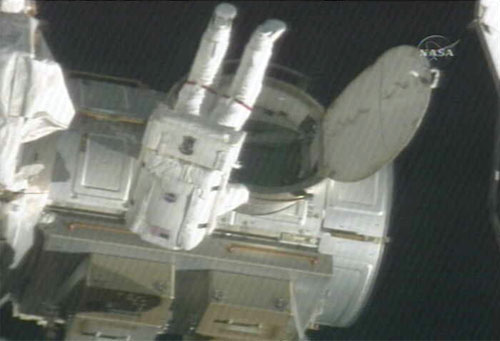 "Go out there and fix that thing for us," radioed ISS Expedition 16 commander Peggy Whitson to Parazynski at the start of the spacewalk. "We will," responded Parazynski. |
Robert Pearlman
Editor Posts: 42988
From: Houston, TX
Registered: Nov 1999
|
 posted 11-03-2007 05:26 AM
posted 11-03-2007 05:26 AM
   
The spacewalkers are configuring tools and tethers before proceeding to the P1 truss, where they will rendezvous with where the orbiter's boom has been positioned for Parazynski. 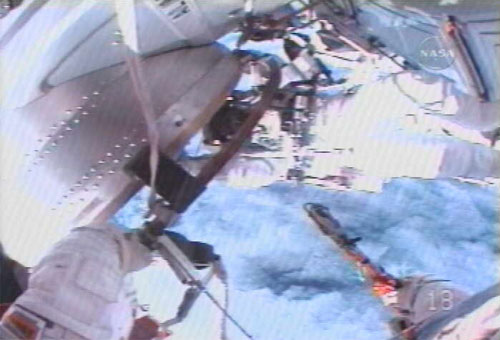 |
Robert Pearlman
Editor Posts: 42988
From: Houston, TX
Registered: Nov 1999
|
 posted 11-03-2007 05:47 AM
posted 11-03-2007 05:47 AM
   
EV-1 Parazynski and EV-2 Wheelock have translated to the P1 truss: 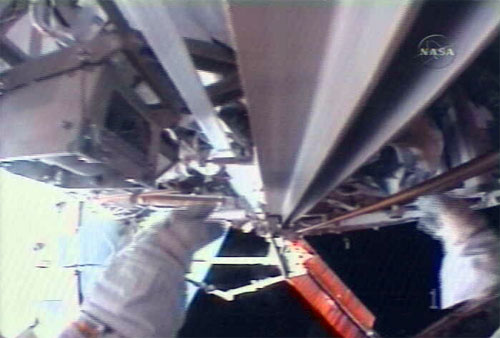 STS-120 commander Pam Melroy reported getting a clearer look at the tear site, relaying to the spacewalkers that the snagged guide wire appears to be tangled, a "furball." Parazynski has translated to the end of the orbiter boom and is working to install the Worksite Interface Fixture (WIF) extender and his portable foot restraint, as well as stowing his tools for the ride up to the array. |
Robert Pearlman
Editor Posts: 42988
From: Houston, TX
Registered: Nov 1999
|
 posted 11-03-2007 05:52 AM
posted 11-03-2007 05:52 AM
   
Parazynski has completed installing the WIF extender on the end of the OBSS. 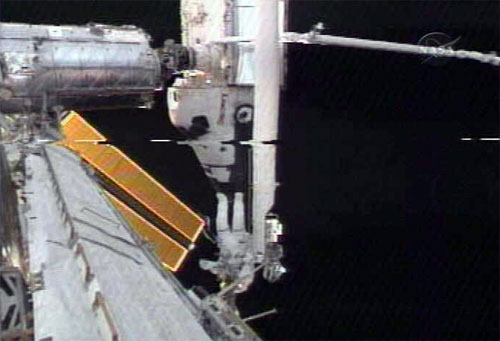 |
Robert Pearlman
Editor Posts: 42988
From: Houston, TX
Registered: Nov 1999
|
 posted 11-03-2007 06:00 AM
posted 11-03-2007 06:00 AM
   
With the portable foot restraint now installed on the OBSS, Parazynski is working to configure his tethers. He earlier reported that with the boom in the parked position, it was very stable. 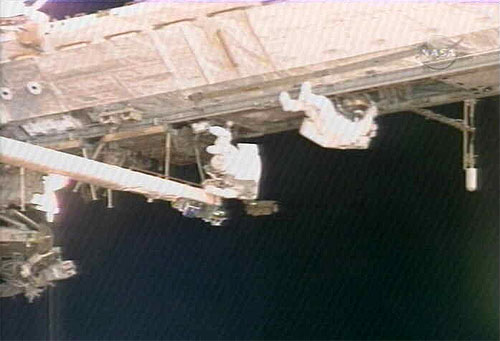 |
Robert Pearlman
Editor Posts: 42988
From: Houston, TX
Registered: Nov 1999
|
 posted 11-03-2007 06:11 AM
posted 11-03-2007 06:11 AM
   
Parazynski is working to ingress the foot restraint on the end of the OBSS, in preparation for his ride to the P6-4B array.  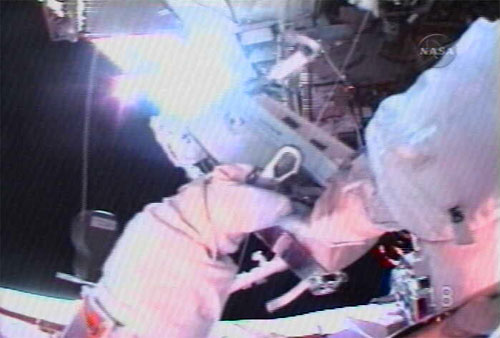 Both spacewalkers are wearing overgloves to protect their primary spacesuit gloves from damage during their work outside the station. |
Robert Pearlman
Editor Posts: 42988
From: Houston, TX
Registered: Nov 1999
|
 posted 11-03-2007 06:16 AM
posted 11-03-2007 06:16 AM
   
With Wheelock providing clearance details, Dan Tani inside the ISS has begun moving the station's robotic arm to assist Parazynski in boarding the boom and its newly installed foot restraint. 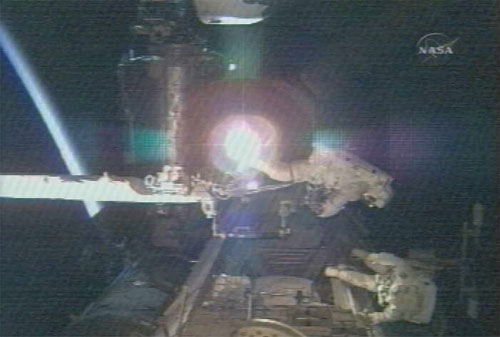 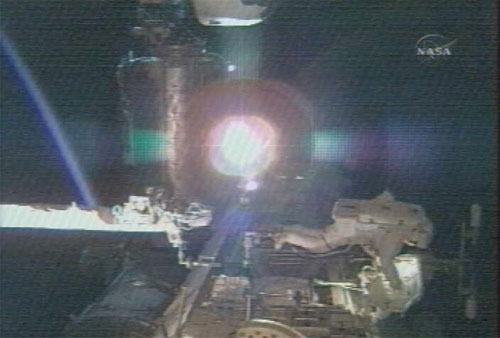 |
fireflyer21
Member Posts: 35
From: Evansville, IN
Registered: Jul 2004
|
 posted 11-03-2007 06:28 AM
posted 11-03-2007 06:28 AM
   
Those in the southeastern US should get a good visual pass of the station/shuttle in the next 15 minutes, around 6:40 am central.Only 20 degrees above the southern horizon here in Indiana, but I think I'll step outside a take a look anyway. |



































